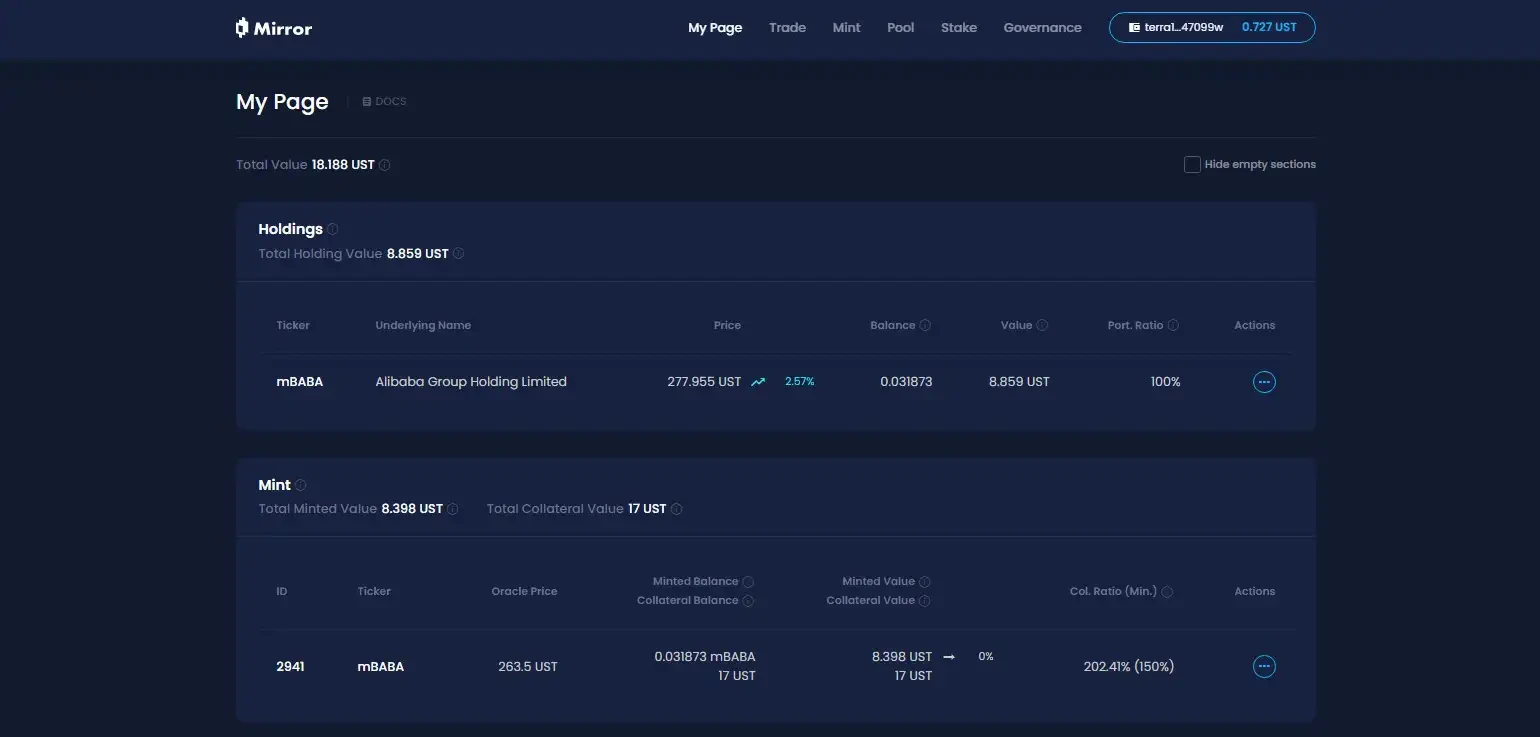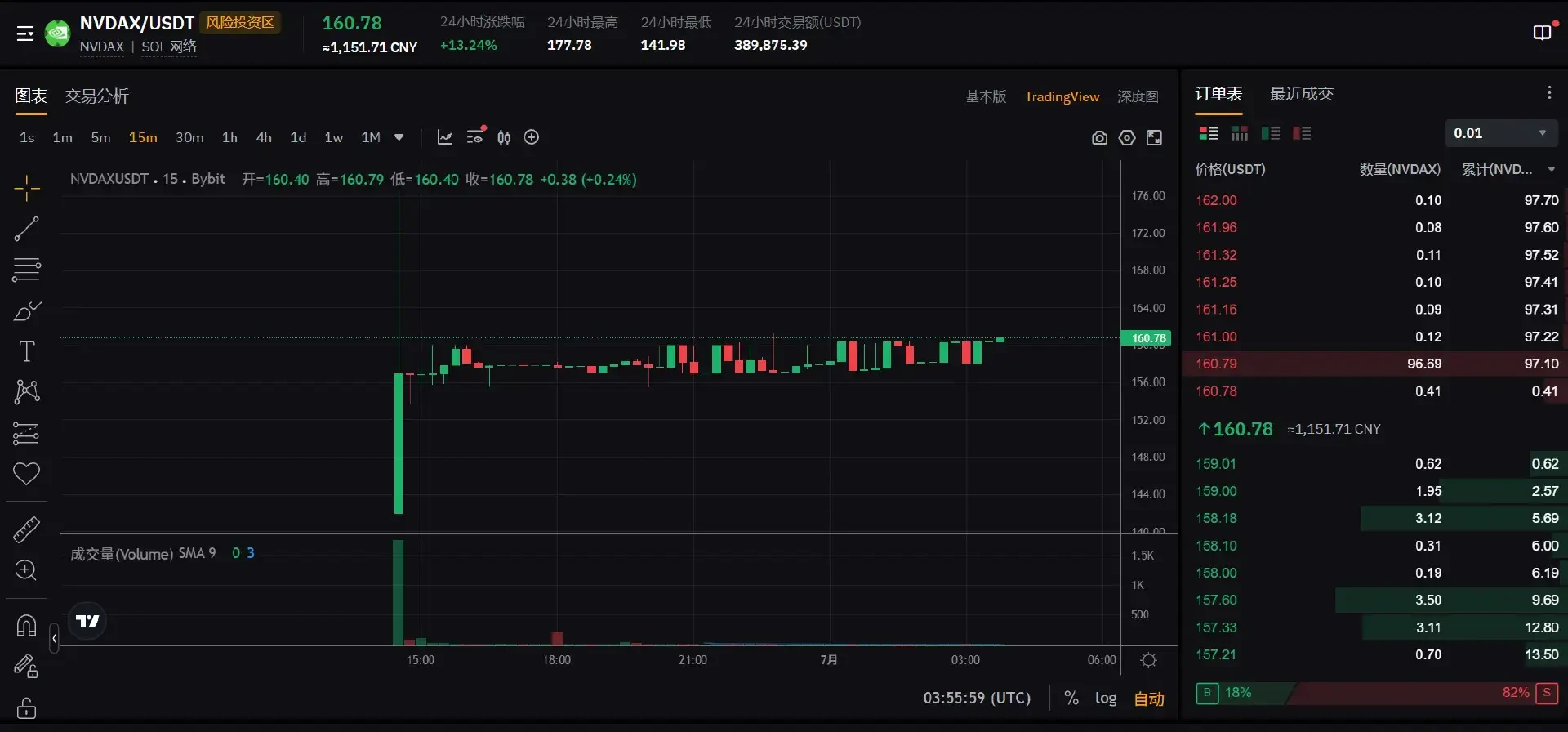Original author: Tyler
Have you ever traded US stocks on the chain?
When I woke up, Kraken launched xStocks, which supported the trading of 60 U.S. stock tokens in the first batch; Bybit followed closely and launched popular stock token pairs such as AAPL, TSLA, and NVDA; Robinhood also announced that it will support U.S. stock trading on the blockchain and plans to launch its own public chain.
Regardless of whether the tokenization wave is just old wine in new bottles, U.S. stocks have indeed become the new darling of the blockchain overnight.
But if you think about it carefully, this new narrative woven by US dollar stablecoins, US stock tokenization and on-chain infrastructure seems to be making Crypto deeply involved in financial narratives and geopolitical games, and inevitably sliding towards a new role positioning.
Tokenization of US stocks is nothing new
The tokenization of U.S. stocks is actually not a new concept.
In the last cycle, representative projects such as Synthetix and Mirror have explored a complete set of on-chain synthetic asset mechanisms. This model not only allows users to mint and trade US stock tokens such as TSLA and AAPL through over-collateralization (such as SNX and UST), but can even cover fiat currencies, indices, gold, and crude oil, covering almost all tradable assets.
The reason is that the synthetic asset model is to track the underlying assets and over-collateralize to mint synthetic asset tokens: for example, if the collateral rate is 500%, it means that users can pledge $500 of crypto assets (such as SNX, UST) into the system, and then mint synthetic assets (such as mTSLA, sAAPL) anchored to the asset price and trade them.
Since the entire operating mechanism uses oracle quotes + on-chain contract matching, all transactions are completed by the internal logic of the protocol and there is no real counterparty. This also gives it a core advantage in theory, which is that it can achieve unlimited depth and slippage-free liquidity experience.

So why is this synthetic asset model moving towards large-scale adoption?
In the final analysis, price anchoring ≠ asset ownership. U.S. stocks minted and traded under the synthetic asset model do not represent actual ownership of the stock. It is just a bet on the price. Once the oracle fails or the collateralized assets collapse (Mirror collapsed due to the collapse of UST), the entire system will face the risk of liquidation imbalance, price de-anchoring, and collapse of user confidence.
At the same time, a long-term factor that is easily overlooked is that U.S. stock tokens under the synthetic asset model are destined to be a niche market in Crypto - funds only circulate within the closed loop on the chain, without the participation of institutions or securities firms, which means that it will always remain at the shadow asset level. It can neither be integrated into the traditional financial system and establish real asset access and funding channels, nor will anyone be willing to launch derivative products based on this, making it difficult to leverage the structural inflow of incremental funds.
So, although they were once popular, they ultimately failed to become popular.
The structure of capital diversion from US stocks under the new framework
This time, the tokenization of U.S. stocks has changed the way things are played.
Taking the U.S. stock token trading products launched by Kraken, Bybit, and Robinhood as an example, from the disclosed information, it is not price anchoring, nor on-chain simulation, but real stock custody, and funds flow into U.S. stocks through securities companies.
Objectively speaking, under this model, U.S. stocks are tokenized. Any user only needs to download a crypto wallet and hold stablecoins, and they can bypass account opening thresholds and identity checks on DEX anytime and anywhere and easily buy U.S. stock assets. There is no U.S. stock account, no time difference, and no identity restrictions in the entire process, and funds can be directly directed into U.S. stocks on the chain.
From a micro perspective, this means that global users can buy and sell U.S. stocks more freely, but from a macro perspective, this is actually the U.S. dollar and the U.S. capital market using Cryptos low-cost, highly flexible, 7 × 24 pipeline to attract incremental global funds - after all, under this structure, users can only go long, not short, and there is no leverage and non-linear return structure (at least so far).

Imagine a scenario like this: a non-Crypto user in Brazil or Argentina suddenly discovers that he can buy US stock tokens on the chain or CEX. He only needs to download the wallet/exchange, convert local assets into USDC, and then click to buy AAPL or NVDA.
It sounds nice to say that it simplifies the user experience, but in fact it is a low-risk, high-certainty U.S. stock capital diversion structure created for global funds. The hot money of Crypto users around the world can flow into the U.S. asset pool across borders with unprecedented low friction through Crypto, allowing people all over the world to buy U.S. stocks anytime and anywhere.
Especially when more and more L2, exchanges, wallets and other native infrastructures are connected to these US stock trading modules, the relationship between Crypto and the US dollar and Nasdaq will become more secretive and more stable.
From this perspective, a series of “new/old” narratives around Crypto are being designed as a set of distributed financial infrastructure specifically for U.S. financial services:
US Treasury Stablecoin → World Currency Liquidity Pool
Tokenization of US stocks → Nasdaq’s traffic portal
On-chain trading infrastructure → Global transit station for US brokerage firms
This may be a flexible way of siphoning global funds. Regardless of whether it has a strong conspiracy theory flavor, at least Trump or the new American speaker after him may fall in love with this new narrative of tokenization of U.S. stocks.
How should we view the pros and cons of “tokenization of U.S. stocks”?
If we look at it purely from the perspective of the Crypto community, is the tokenization of U.S. stocks attractive? Or what impact might it have on the on-chain cycle?
I think we need to look at it dialectically.
For users who lack access to U.S. stock investment channels, especially Crypto natives and retail investors in third world countries, the tokenization of U.S. stocks has opened up an unprecedented low-threshold channel, which can be called asset equality that transcends barriers.
After all, as a supermarket where star stocks such as Microsoft, Apple, Tesla, and Nvidia have emerged one after another, the historic long bull of U.S. stocks has always been talked about by the investment community and is one of the most attractive asset classes in the world. However, for most ordinary investors, the threshold for participating in transactions and sharing dividends has always been relatively high: account opening, deposits and withdrawals, KYC, regulatory restrictions, trading time differences... Various thresholds have discouraged countless people.
Now, as long as you have a wallet and a few stablecoins, you can buy Apple, Nvidia, and Tesla anytime and anywhere, even in Latin America, Southeast Asia, and Africa, making U.S. dollar assets accessible to global users. In short, for underdeveloped regions where local assets cannot outperform U.S. stocks or even inflation, the tokenization of U.S. stocks undoubtedly provides unprecedented accessibility.
On the other hand, within the Crypto circle, especially among trading users represented by the Chinese-speaking region, there is actually a high degree of overlap with the U.S. stock investment circle. Most people already have U.S. stock accounts and can access the global financial system with one click through banks + overseas brokerages such as Interactive Brokers (I personally use a combination of SafePal/Fiat 24 + Interactive Brokers on a daily basis).
For these users, the tokenization of U.S. stocks seems a bit half-baked - they can only go long, there are no derivatives to support them, and there are not even basic options and short selling, so it is not really transaction-friendly.

As for whether the tokenization of U.S. stocks will further drain blood from the crypto market, don’t rush to deny it. I think this may be an opportunity window for a new round of asset Lego after the DeFi ecosystem clears out low-quality assets.
After all, one of the biggest problems with current on-chain DeFi is the serious lack of high-quality assets. Apart from BTC, ETH, and stablecoins, there are not many assets with real consensus on value. A large number of altcoins are of poor quality and experience severe fluctuations.
If these real-stock custody and on-chain issued US stock tokens can gradually penetrate into DEX, lending protocols, on-chain options and derivatives systems in the future, they can become new underlying assets, supplement the on-chain asset portfolio, and provide DeFi with more certain value materials and narrative space.
Moreover, the current U.S. stock tokenization products are essentially spot custody + price mapping, without leverage and non-linear return structure, and naturally lack deep financial instrument support. It depends on who can first make products with strong composability and good liquidity, and who can provide an integrated on-chain experience of spot + short selling + leverage + hedging.
For example, it can be used as high-credit collateral in lending agreements, as a new hedging target in option agreements, and as a combinable asset basket in stablecoin agreements. From this perspective, whoever can be the first to create an integrated on-chain trading experience of spot + short selling + leverage + hedging will be able to create the next on-chain Robinhood or on-chain Interactive Brokers.
And for DeFi, this may be the real turning point.
It depends on who can reap the benefits of on-chain products from this wave of new narrative.
Last words
Starting from 2024, Can Crypto still revolutionize TradFi is no longer a question worth discussing.
Especially since this year, penetrating the geographical limitations of traditional financial channels through stablecoins, bypassing sovereign barriers, tax obstacles, and identity checks, and ultimately establishing a new dollar channel with Crypto has become a core theme of many narratives that have recently begun with compliant dollar stablecoins.
Crypto bless America, maybe it’s not just a joke.










